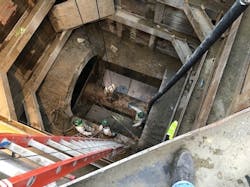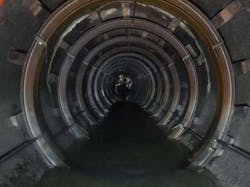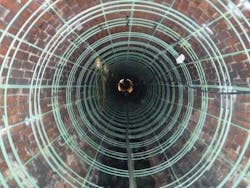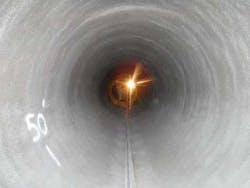CON-149 Emergency Rehabilitation of the Northwest Interceptor
Cost: $3 million
Location: Detroit, Michigan
Year: 2020-12-31
Size: 18,000 gpm dry weather flow
55,000 gpm wet weather flow
Owner: Great Lakes Water Authority
Designers: FK Engineering Associates
Applied Science Inc.
Contractor: Inland Waters Pollution Control
Inland Waters Pollution Control Inc. (IWPC), a subsidiary of Inland Pipe Rehabilitation LLC (IPR), oversaw the design and performed the rehabilitation of more than 2,700 linear feet of a 6-foot, 3-inch inner diameter Northwest Interceptor (NWI) sanitary sewer rehabilitation in Detroit, Michigan, which is part of Great Lakes Water Authority (GLWA).
Rehabilitation included the construction of two flow control chambers, emergency support of an actively failing tunnel and a complete relining of more than 800 linear feet. Originally built in 1929, the NWI services hundreds of thousands of residents and businesses in places, including Detroit and surrounding communities.
The initial planning for the rehabilitation project started immediately after the team performed manned entry of the damaged sections of sewer and found large open and offset cracks, as well as sections of pipe wall that were missing. This identified the immediate challenge of preventing complete collapse of the pipe.
“GLWA’s initial expectations were that the sewer could be safely and cost effectively repaired without any non-permitted discharge to the environment,” said Mini Panicker, engineer for GLWA and project manager for this project. “It was understood at the beginning that this was a challenging project and the initial expectation was to prevent further progression of the ongoing damage and to stabilize the sewer so that an engineered repair could be performed.”
The initial planning stages were largely focused on coordinating between potential repair methods and the feasible flow control methods available. Early on, the team concluded long term complete bypassed flow would be extremely expensive and that incremental repair methods were available that could be completed during dry weather.
Panicker said the secondary expectations were for a final repaired sewer lining that would result in a stabilized and repaired interceptor which would not require significant future repairs for 25 to 50 years.
Another major challenge was the small size of the interceptor. Heavy manual and skilled labor was required to access and initially stabilize the interceptor under full flow conditions. As a result, approximately 18,000 gallons per minute (gpm) of dry weather flow was controlled and diverted using the new control structure and gate. During wet weather events, NWI carries flow between 50,000 gpm and 55,000 gpm.
Additional inspections and procedures were required due to several major structural defects over the hundred feet of the NWI. To handle this, remote operated vehicle inspections and manned entry inspection were performed.
Further complicating things, the NWI flow rate interfered with the manned entry inspections, so the entrant could not inspect beyond 150 feet from the entry manhole without risk. Bypass flow was required and included a diversion chamber with a gate upstream of the repair area.
The initial manned walk through the interceptor was a significant achievement due to the extreme difficulty in making walkthrough swift and the high flows that needed to be controlled. Emergency procedures were implemented to avoid the collapse of NWI including rib and lagging support, steel installation, and cement grout installation.




